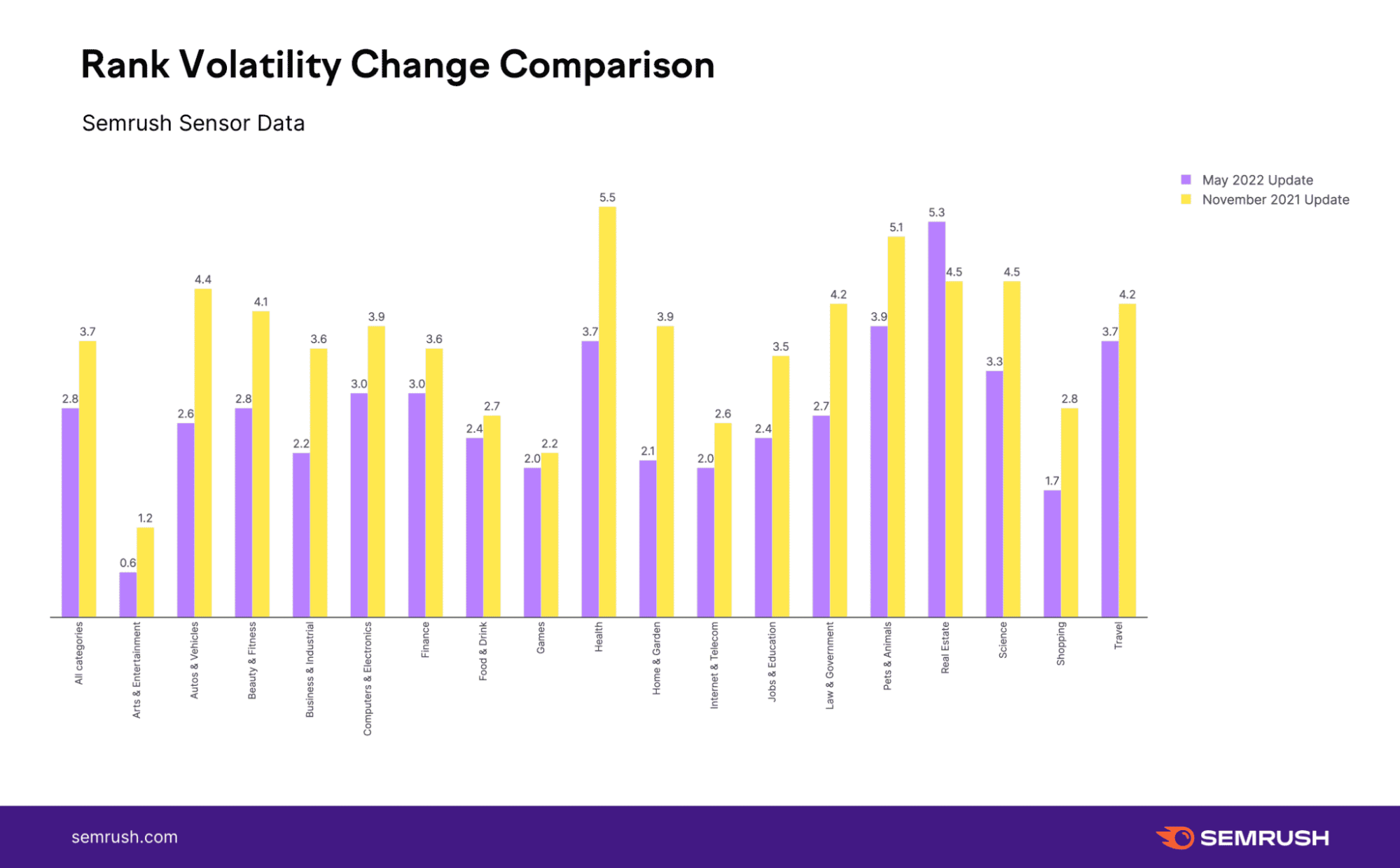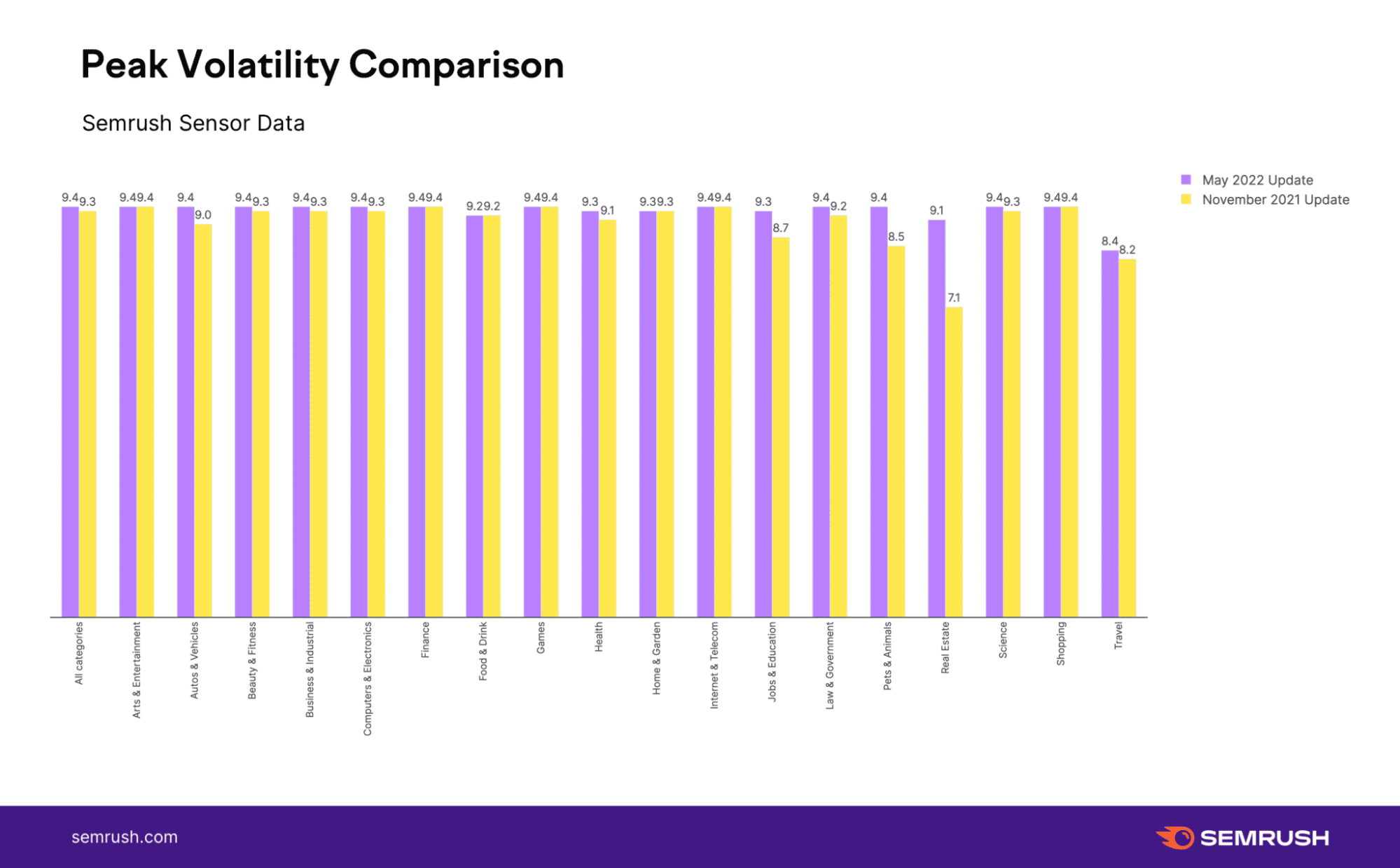Last week, Google rolled out its May 2022 broad core algorithm update. The update was officially named the May 2022 core update, and it was the first broad core update since the November 2021 broad algorithm update.
“Today, we are releasing a broad core update, as we do several times per year. This update is called the May 2022 core update. Learn more,” announced Google.
The May 2022 core update started rolling out on May 25. Although the expected time frame for the update to fully roll out was two weeks, we have already seen a big impact in search rankings in many different niches.
High volatility
According to multiple data providers, the May 2022 core update brought high volatility.
Following is an image from the SEMRush Sensor tool that measures volatility in search engine rankings.

The high volatility at the start of the broad core algorithm rollout has become a kind of a norm. This pattern was also observed in the last few broad core updates.
According to Mordy Oberstein, SEMRush Communication Advisor, “this is already the third core update in a row where the initial rollout saw a very short burst of initial rank volatility.”
RankRanger also analyzed the impact of the May 2022 broad core update on search engine rankings and volatility, and their results painted a similar picture — a high peak of search engine volatility immediately after the update started rolling out.
 May 2022 vs. November 2021 — Which core update was more volatile?
May 2022 vs. November 2021 — Which core update was more volatile?
At first glance, it seems like the November 2021 update caused a higher degree of volatility in search engine rankings — at least, that looked like the case for most industries.
 As you can see in the above chart, the November 2021 update had a higher volatility score for almost all niches.
As you can see in the above chart, the November 2021 update had a higher volatility score for almost all niches.
However, if you look closely, there is more nuance to that. That is because the average level of search volatility just before the May 2022 core update rolled out was higher than the average search volatility before the November 2021 update.
So if you take that into account, you get the following figure.

This means that the May 2022 broad core update might actually be more volatile than the November 2021 broad core update we got last year.
The RankRanger team also analyzed the data to identify which industry or niche might have been affected the most by the May 2022 algorithm update. According to their findings, among the health, finance, retail, and travel industries, the retail industry saw the biggest impact.

What are broad core algorithm updates?
In case you have been wondering, here is a simple explanation of what broad core algorithm updates are and why they happen so regularly.
According to Google, “core updates are changes we make to improve Search overall and keep pace with the changing nature of the web. While nothing in a core update is specific to any particular site, these updates may produce some noticeable changes to how sites perform, which we’ve noted in previous guidance on what site owners should know about core updates.”
As evident by this explanation, core algorithm updates are a part of how the Google search engine algorithm continues to evolve. Although Google rarely tells us specifically what a core update is going to focus on, the biggest focus is almost always on the relevance and usefulness of search results.
How to protect your website from broad core updates
Before we share some tips with you, it is important to understand that broad core updates are not necessarily bad. Yes, they can be scary because if something goes wrong, it might directly affect your search traffic, sales, and revenue. But if you have been following Google’s recommended best practices, you should be fine.
As mentioned earlier, the main focus should be on producing the most relevant and useful content for search engine users (and your website visitors).
Here are some more specific tips to help you safeguard your website against potential future broad core updates:
- Focus on producing high-quality content.
- Make sure your web content is trustworthy, easy to consume, comprehensive, original, and useful.
- Optimize only for relevant search queries.
- Strategically create different pages to target different keyword groups — based on the current search engine results and the searcher’s intent.
- Make sure the title of the web page is an accurate description of the page.
- Double-check that the pages on your site are free from basic errors: spelling mistakes, stylistic issues, factual inaccuracies, etc.
- Pay extra attention to how your website is viewable on mobile devices.
- Create and review your content in accordance with the quality rater guidelines.
Apart from that, it is also a good idea to keep a close eye on important traffic and SEO metrics. We recommend using tools like Google Analytics and Google Search Console to monitor how your website is performing.
However, monitoring the site performance closely does not necessarily mean that you jump in every time there is a slight dip in traffic.
You can ignore small fluctuations
Google’s John Mueller recently mentioned that it is typically safe to ignore small fluctuations in search traffic and site performance. That’s because not all fluctuations are caused by something you did. Oftentimes, things change because of Google’s own “incredibly complex and interconnected systems.”
Here is how John Mueller explained it.
“Google Search includes many incredibly complex and interconnected systems. Even small changes on one side can have a surprisingly visible effect. These changes tend to even themselves out overall. But when looking at the individual parts, they can still be noticeable.
For example, if crawling from one data center is minutely faster than usual, then that could cause changes to the content we have available for indexing. And, in turn, the content shown in search results. Perhaps you write an insightful social media post that suddenly becomes important, and our system is focused on that a bit more. Either way, any of this could cause fluctuations in the charts.”
“Don’t worry about the little changes,” John clarified. “These are normal for any website. Things go up a bit, things go down a bit. That’s all fine.”
“[Instead] lookout for trends. Has the graph been continuously headed in one direction over a few weeks? Then that’s often a sign of broader changes overall. Watch out for big spikes. When the graphs change significantly over a short period, that could be a sign of a serious change. It might be a good change, but I’d recommend you double-check.”
Conclusion
If your website was hit by the May 2022 broad core update, there is no one specific action you can take to fix that.
And as mentioned earlier, a decrease in search rankings after a core update does not necessarily mean that there is something wrong with your website. It may simply mean that there is now some other page on the SERP that is more relevant and useful than your web page for a specific search query.
Having said that, Google has offered a list of questions that you should consider if your website was hit by a broad core update.
It is important to note that your website rankings may not recover right away — even after you have changed things. You may have to wait until the next core update rolls out to see any effects.
In the meantime, keep a close eye on your Google Analytics and Google Search Console account and see if you can find a positive or negative trend.
